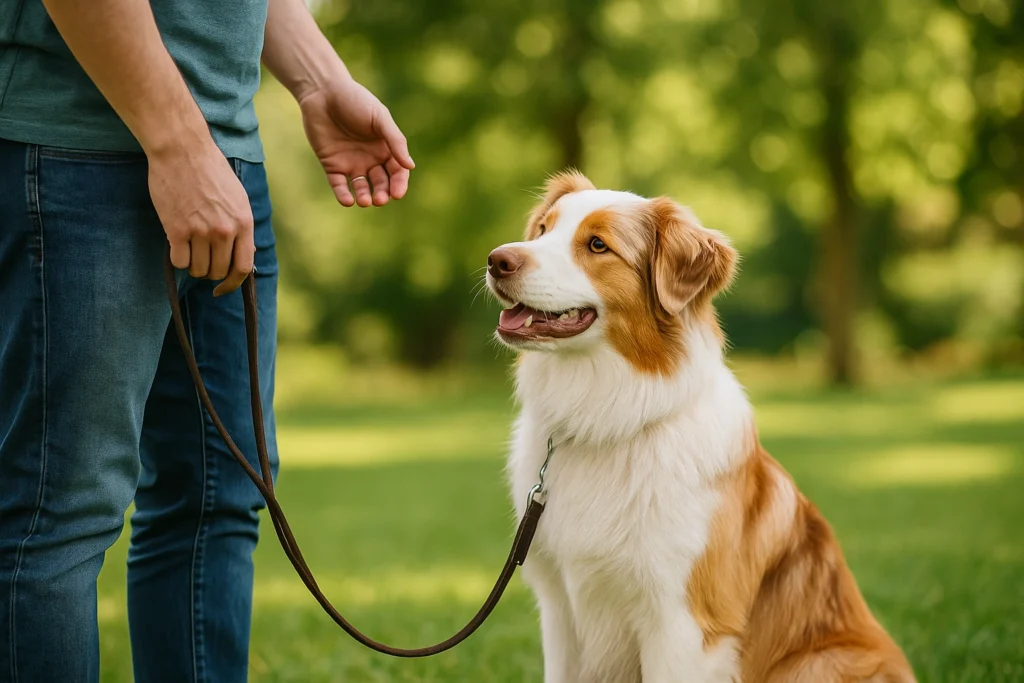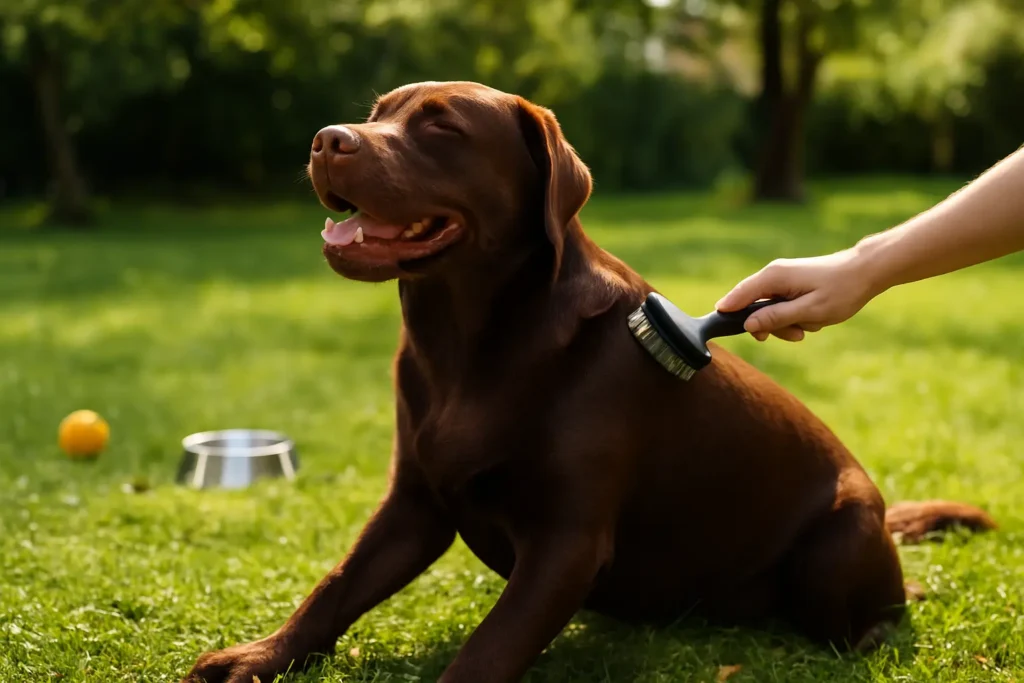Bringing a new dog into your life is exciting but it can also feel overwhelming when training doesn’t go as planned. So, when should you call a professional dog trainer for help?
The short answer: If your dog shows aggression, fear, destructive behavior that isn’t improving, or if you feel stuck despite consistent effort, it’s time to bring in a professional.
Dog training is more than teaching commands; it’s about building a safe, trusting relationship between you and your pet. While many owners successfully teach basics like Sit, Stay, and Come at home, some issues go beyond DIY training. That’s where certified trainers and behaviorists step in; they can help with aggression, anxiety, leash reactivity, or serious obedience struggles that risk your dog’s safety and your peace of mind.
It’s important to know that asking for help doesn’t mean you’ve failed as a dog owner. In fact, recognizing when you need guidance is the smartest decision you can make for both you and your dog. Think of it like this: You might handle basic fitness on your own, but if you’re recovering from an injury, you’d hire a physiotherapist. The same applies to dogs; some challenges need expert eyes and structured training.
In this guide, we’ll cover:
- The top signs you need a professional dog trainer
- The different types of trainers and behaviorists available
- The benefits of hiring a professional vs. DIY training
- How to choose the right trainer for your needs
- Real-world stories of owners who turned training struggles into success
By the end, you’ll know exactly when it’s time to seek help, and how to make the best choice for your dog’s long-term happiness and behavior.
2. Why Dog Training Matters for Every Owner
Dog training isn’t just about teaching tricks, it’s about communication, safety, and trust. Whether you’re raising a playful puppy or caring for an older rescue, the way your dog learns in the first weeks and months has a lasting impact on your relationship.
Training Builds Communication
Dogs don’t speak our language, and owners don’t naturally understand canine body language. Training bridges this gap. Commands like Sit, Stay, and Come are more than obedience cues; they become a common language that helps you guide your dog in daily life. Without this foundation, frustration builds on both sides.
Training Ensures Safety
A well-trained dog is a safe dog. Imagine a situation where your dog runs toward a busy street. If your recall (“Come”) isn’t strong, their safety is at risk. Or consider leash pulling not only is it exhausting, but it can also lead to injuries for both you and your dog. Training reduces these risks by teaching boundaries and self-control.
Training Strengthens the Bond
Positive reinforcement training isn’t just effective; it also deepens your connection with your dog. When your pup learns that listening to you leads to rewards, play, and praise, they develop trust. This bond makes future learning easier and more enjoyable.
Why Professional Help Sometimes Matters
Even with the best intentions, some challenges go beyond the basics. For example, while most owners can teach crate training or housebreaking, issues like separation anxiety or dog-to-dog aggression often need a professional’s expertise. Recognizing when to move from DIY to guided support is key and it often saves time, money, and stress in the long run.
Dog training is not a one-size-fits-all journey. Some dogs are quick learners, while others may struggle due to temperament, past trauma, or simply stubbornness. As an owner, your role is to set the foundation but when behaviors become overwhelming, that’s where a professional steps in.
This section sets the why before we dive into the signs you need professional help (next section).
3. Signs It’s Time to Call a Professional Dog Trainer
Not every challenge requires expert help but certain behaviors are clear signals that it’s time to bring in a professional. Knowing these signs early can prevent frustration, protect your home, and keep your dog safe and happy.
Aggression or Reactivity in Dogs
If your dog growls, lunges, snaps, or bites whether at people, other dogs, or even family members this is not a “wait and see” situation. Aggression can escalate quickly and lead to dangerous outcomes.
📌 Why call a trainer:
Professional dog trainers (or behaviorists) are trained to identify the root cause of aggression, fear, dominance, resource guarding, or lack of socialization and create a safe plan to correct it.
Excessive Anxiety or Fearfulness
Dogs that constantly tremble, hide, bark excessively, or panic when left alone may be struggling with anxiety. Separation anxiety, noise phobias (like fireworks), or extreme fear of strangers are more than training issues; they’re emotional challenges. The ASPCA’s guide to separation anxiety provides additional resources for concerned pet parents.
📌 Why call a trainer:
A certified trainer or behaviorist can introduce controlled exposure, confidence-building exercises, and calming routines to help your dog feel safe. Sometimes, they’ll also work alongside your vet if medical support is needed.
Destructive Behavior That Won’t Stop
Chewed shoes, scratched doors, torn couches, puppies explore with their mouths, but if destruction continues despite consistent corrections, it’s a sign of deeper issues like boredom, frustration, or anxiety.
📌 Why call a trainer:
Professionals help channel destructive energy into safe outlets (toys, structured play) and address the triggers that cause it.
Leash Pulling and Walk Struggles
Walking should be enjoyable, not a tug-of-war. Constant pulling, lunging at dogs or people, or refusal to walk can turn walks into stressful battles.
📌 Why call a trainer:
A trainer can teach proper leash manners using positive reinforcement, ensuring walks are safe and calm.
No Progress Despite Consistent Training
You’ve watched tutorials, read books, and practiced daily but your dog still isn’t responding. This plateau is frustrating and can make owners feel like giving up.
📌 Why call a trainer:
Trainers see things you might miss like inconsistent timing, unclear cues, or environmental triggers. Sometimes, just one professional session can break the cycle and reset your progress.
Safety Risks to Family or Other Pets
If your dog’s behavior puts children, elderly family members, or other pets at risk even accidentally it’s time to call for professional guidance. Safety always comes first.
👉 These are the red flags that Google’s users often type in when searching things like “signs you need a dog trainer” or “when to hire a professional dog trainer”.
4. Types of Professional Dog Trainers
Not all trainers handle the same issues. Depending on your dog’s needs, you may need a basic obedience coach, a certified behaviorist, or even a specialist. Here are the main options:
Obedience Trainers (Basic Manners & Commands)
If your dog needs help with foundation skills Sit, Stay, Come, Heel or struggles with leash manners, obedience trainers are the right choice. These trainers focus on everyday skills that make life easier for both you and your pup.
📌 Best for: Puppies, first-time owners, and dogs needing structure in daily routines.
Certified Dog Behaviorists
When issues go beyond manners such as aggression, extreme fear, or separation anxiety a dog behaviorist is often the best option. Unlike obedience trainers, behaviorists specialize in the psychology of dogs and may work with vets if medication is needed.
📌 Best for: Dogs with reactivity, anxiety disorders, or serious aggression.
Specialist Trainers
Some dogs need training for specific roles or sports. Specialist trainers work on tasks like therapy work, service dog training, agility, or scent detection. These trainers go beyond obedience to teach advanced skills tailored to the dog’s purpose.
📌 Best for: Owners who want their dog to participate in specialized activities or jobs.
Board-and-Train Programs
In these programs, your dog stays with a trainer for days or weeks while receiving intensive, hands-on training. While results can be impressive, it’s important to choose facilities that use positive reinforcement methods.
📌 Best for: Busy owners, or dogs with persistent issues that require concentrated work.
Group Classes vs. Private Training
- Group Classes: Affordable, social, good for puppies learning around distractions.
- Private Training: Tailored to your dog’s specific issues, often faster results.
5. Benefits of Hiring a Professional Dog Trainer
Calling a professional isn’t a sign of weakness, it’s one of the smartest investments you can make in your dog’s future. Here’s why hiring a certified dog trainer can make a world of difference.
Faster, More Reliable Results
Professional trainers have years of experience spotting patterns that most owners miss. They know how to adjust timing, cues, and rewards to get results quickly. What might take you months of trial and error can often be solved in a few guided sessions.
Personalized Training Plans
Every dog is unique. A one-size-fits-all YouTube tutorial can’t address your dog’s specific personality, history, and triggers. Trainers create customized training plans that adapt to your dog’s needs, your lifestyle, and your goals.
Improved Communication Between You and Your Dog
Sometimes the problem isn’t the dog, it’s the clarity of the message. Trainers teach owners how to give consistent commands and body signals, ensuring the dog understands what’s expected. This makes daily life smoother and less stressful.
Addressing Serious Behavior Issues
Problems like aggression, fear, and separation anxiety aren’t solved with “quick fixes.” Trainers use proven, positive reinforcement strategies to address the root cause of these behaviors instead of just suppressing them. Learn more about dog aggression signs from the American Kennel Club (AKC)
Confidence and Peace of Mind
One of the most overlooked benefits of hiring a professional dog trainer is the confidence it gives you as an owner. Knowing you’re on the right path reduces stress and helps you enjoy life with your dog. A calmer owner = a calmer, better-behaved dog.
Long-Term Success
Professional training isn’t just about fixing today’s issues. It builds a foundation for a lifetime of good behavior, making it easier to add new skills or adjust routines as your dog grows older.
👉 Whether your goal is basic obedience, stopping bad habits, or handling complex behavioral challenges, a professional dog trainer can save time, reduce frustration, and strengthen the bond you share with your dog.
6. DIY Training vs. Professional Training: Where’s the Line?
As a dog owner, it’s natural to want to train your pup yourself. Many owners successfully teach basic commands and household manners without ever calling a professional. But there’s a point where DIY training is enough and a point where professional support is the safer, smarter choice.
When You Can Train at Home
Most dogs can learn foundation skills with patience, consistency, and positive reinforcement. If you’re dealing with everyday puppy behaviors, you can usually manage training on your own.
- House Training & Crate Training – Teaching your pup where to potty and creating a safe space.
- Basic Obedience Commands – Sit, Stay, Come, Down, Heel.
- Polite Manners – Waiting for food, not jumping on guests, gentle play.
- Leash Training – Mild pulling can be fixed with proper technique and consistency.
With the right tools (treats, clicker, leash) and a structured routine, most owners can manage these areas without professional help.
When a Trainer Is Essential
Certain behaviors go beyond what most owners can handle alone. These require expert guidance to ensure safety and long-term success.
- Aggression – Growling, biting, lunging at people or other dogs.
- Severe Separation Anxiety – Destructive behavior, nonstop barking, escape attempts.
- Extreme Reactivity – Overwhelming fear of noises, strangers, or new environments.
- Uncontrollable Leash Pulling – Strong dogs pulling dangerously, risking injury.
- No Progress Despite Consistent Training – Hitting a plateau where nothing seems to work.
The Middle Ground: When in Doubt, Get a Consultation
Sometimes you don’t need a full training package, just an expert eye. Many trainers offer single consultation sessions where they observe your dog, spot issues, and give you a plan to follow. This can be enough to get you back on track without a huge commitment.
👉 The key takeaway: If your dog’s behavior is unsafe, unmanageable, or not improving despite your efforts, it’s time to call a professional dog trainer.
7. How to Choose the Right Professional Dog Trainer
Not all trainers are created equal. The wrong trainer can set your dog back or even cause more problems. The right one will make learning fun, effective, and safe. Here’s how to make sure you choose wisely.
Look for Certifications and Credentials
Anyone can call themselves a dog trainer but certifications show a commitment to learning and ethical methods. Reputable certifications include:
- CPDT-KA (Certified Professional Dog Trainer – Knowledge Assessed)
- IAABC (International Association of Animal Behavior Consultants)
- CCPDT (Certification Council for Professional Dog Trainers)
📌 While certifications aren’t everything, they’re a strong sign of professionalism.
Ask About Training Methods
This is crucial. A trainer who uses punishment, shock collars, or intimidation can harm your dog’s trust. Instead, look for trainers who emphasize positive reinforcement rewarding good behavior rather than punishing mistakes.
👉 Red Flag: If a trainer talks about “dominance” or “alpha rolls,” steer clear.
Check Reviews and Referrals
Ask your vet, local rescue groups, or friends for recommendations. Read reviews carefully look for consistent praise about kindness, patience, and results.
Observe a Class or Session
Most trainers will let you sit in on a class before committing. Watch how they interact with both dogs and owners. Are the dogs happy and engaged? Are the owners comfortable and included?
Consider Costs and Packages
Professional training can be an investment. Prices vary depending on location, trainer experience, and whether you choose group classes, private sessions, or board-and-train programs.
- Group classes: $100–$300 for several weeks.
- Private sessions: $50–$150 per hour.
- Board-and-train: $1,000+ for multi-week programs.
The right option depends on your dog’s needs and your budget.
Trust Your Instincts
If something feels off during your first consultation, trust your gut. A good trainer should make both you and your dog feel comfortable.
👉 Choosing the right trainer is about more than skill it’s about building a partnership of trust, respect, and results.
8. Real-World Case Studies: When Professional Help Changed Everything
Sometimes the best way to understand the value of a professional dog trainer is through real-life examples. These stories show how everyday owners turned difficult situations around with the right help.
Case Study 1: Bella the Labrador – From Leash Chaos to Calm Walks
Bella, a 1-year-old Labrador, loved her walks maybe a little too much. She pulled so hard on the leash that her owner, Emma, dreaded leaving the house. After weeks of DIY YouTube training, nothing changed.
👉 Emma called a certified trainer, who immediately spotted the issue: Bella wasn’t being rewarded for calm walking, only corrected when she pulled. Within three sessions, Bella learned to walk politely at Emma’s side. Today, their daily walks are stress-free and enjoyable for both.
Case Study 2: Rocky the Rescue Shepherd – Overcoming Fear Aggression
Rocky, a German Shepherd rescue, had a rough past. He growled and lunged at strangers, making it difficult for his owner, James, to take him out in public.
👉 James turned to a certified dog behaviorist. Using controlled exposure and positive reinforcement, they helped Rocky slowly build confidence. Over time, Rocky learned to stay calm around new people. James now proudly says his dog enjoys park outings without incident.
Case Study 3: Luna the Beagle – Separation Anxiety Solved
Every time Luna’s owner, Priya, left the house, Luna howled, chewed furniture, and scratched doors. Priya tried crate training and leaving toys, but nothing worked.
👉 A professional trainer created a step-by-step desensitization plan: short absences, calm returns, and gradual increases in alone time. With patience and structure, Luna went from panicked to peaceful. Priya now leaves for work without fear of coming home to destruction.
📌 These examples prove an important point: sometimes it’s not about trying harder, it’s about getting expert guidance. The right trainer can transform even the most frustrating behavior into progress and peace.
9. Frequently Asked Questions About Hiring a Professional Dog Trainer
Q1: What is the best age to hire a dog trainer?
You can hire a trainer as soon as your puppy comes home, usually around 8 weeks old. Early training helps prevent bad habits from forming. But it’s never too late for adult and senior dogs to benefit from professional training too.
Q2: Can an older dog still learn from a professional trainer?
Yes! The saying “you can’t teach an old dog new tricks” is a myth. Older dogs may take a little longer, but with consistency and the right trainer, they can learn new behaviors and correct old habits.
Q3: How do I know if I need a behaviorist instead of a trainer?
If your dog struggles with aggression, severe anxiety, or compulsive behaviors, you may need a dog behaviorist, who specializes in emotional and psychological issues. For basic obedience or manners, a certified dog trainer is usually enough.
Q4: Is group training or private training better?
It depends on your dog’s needs. Group classes are great for socialization and learning around distractions. Private training is best for dogs with specific behavioral challenges or owners who want faster, one-on-one progress.
Q5: How much does professional dog training cost?
Costs vary by location and service:
- Group classes: $100–$300 for 4–6 weeks
- Private sessions: $50–$150 per hour
- Board-and-train programs: $1,000+ for multi-week stays
Think of it as an investment in your dog’s lifelong behavior and safety.
Q6: Do professional dog trainers guarantee results?
No trainer can guarantee results, because every dog is unique. However, certified trainers using positive reinforcement methods will give you the tools and support to achieve consistent progress.
📌 These FAQs give readers quick, trustworthy answers — and also help capture extra search traffic.
10. Conclusion: Don’t Wait Too Long to Call a Professional Dog Trainer
Training your dog on your own is rewarding but sometimes, despite your best efforts, you’ll hit a wall. That’s the moment to ask: “Is it time to call a professional dog trainer?” If your dog shows aggression, severe anxiety, destructive behaviors, or you’ve tried everything with no success, the answer is yes.
Getting help doesn’t mean you’ve failed. In fact, it shows you care enough to make the best choice for your dog’s well-being. A certified trainer or behaviorist can spot problems faster, create a tailored plan, and guide you toward a calmer, safer, and happier relationship with your dog.
Remember:
- Use DIY training for basics like Sit, Stay, and leash manners.
- Seek professional help for aggression, anxiety, or stubborn behaviors.
- Always choose trainers who use positive reinforcement methods.
The sooner you act, the sooner you and your dog can enjoy stress-free walks, calm behavior at home, and a bond built on trust.
👉 If you’re just getting started, check out our guide on the Benefits of Early Dog Training for New Owners or explore the 10 Essential Dog Training Commands every first-time owner should teach.
Your dog deserves the best start possible and sometimes, that means calling in the pros.




